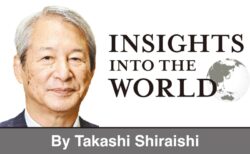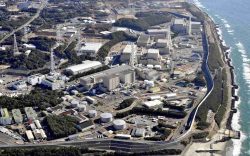11:00 JST, September 6, 2024
People need food and water to survive. But will we have sufficient supply of these necessities in the future?
Four years ago, writing in this column, I discussed how difficult the water and food situation was likely to become going forward. At the time, I took a somewhat pessimistic view of things. So now I would like to examine whether there isn’t some light at the end of the tunnel when it comes to solving water and food insecurity.
I asked whether we would have enough food and water. But posing the problem in this way is a bad habit, a sort of tunnel vision that is typical of economy-linked people and others who think in a similar manner. They believe deeply that demand is an expression of the human pursuit of happiness and, therefore, that we should seek to increase supply if demand grows.
However, if I understand correctly the Club of Rome’s 1972 report titled “The Limits of Growth,” the question is not whether there will be enough of what humans need, but whether humanity can balance supply and demand. The report warned that if economic growth continued to be pursued amid explosive population growth, the planet’s ecological systems would collapse within 100 years due to depletion of food and nonrenewable resources. There are only 50 or so years left.
Meeting water demand
What do people need water for? Ask generative AI for an answer, and it readily lists five or six different uses. Its answer is not wrong, but we should reexamine our priorities for water use.
When it comes to flush toilets, I have absolutely no intention of calling for an end to their use. But, some of them can probably be replaced with vacuum toilets. I may be an amateur in this area, but it seems to me that, even if it is difficult to replace toilets at people’s homes, it may be feasible for large-scale facilities to switch to vacuum toilets.
It is also useful to consider “recycling methods,” such as using recycled water to flush toilets. Singapore, for example, recycles wastewater at the city level. In addition to using treated wastewater for toilets, the city-state turns treated water into safe, clean drinking water known as “NEWater.”
It is often said that Japan and the Philippines squander their water resources. Even if a big rain comes, the water washes quickly down the steep mountains and flows into the sea. If this is the reason why rainwater is so poorly utilized, we should seriously consider building large reservoirs at the mouths of rivers to store water.
These are examples of what could be done to conserve liquid water. But we also need to think about what should be done for the regions that lack sea access or rivers and where it hardly rains.
First, we should ask how much usable fresh water there is on earth. The answer is 0.01% of the world’s water, including seawater — an unimaginably small fraction of the whole.
Technologies are being developed to turn water vapor in the air into liquid water like water beading on glasses. Researchers are apparently trying to downsize equipment and reduce the amount of electricity consumed. Such technology is expected to be used in arid areas — especially sparsely populated areas that lack water.
The earth’s fresh water supply includes enormous resources that are not readily usable — most of which is trapped in ice such as glaciers in the polar regions and high mountains. The idea of transporting such ice or water melted from such ice has been around for a long time. Nonetheless, little progress has been made in this area because of the huge transportation costs.
However, if the problem just comes down to money, we should give this scheme a fresh look well before glaciers’ ice walls begin collapsing. Costs are a big issue, but I think now is the time to decide whether to prioritize water access or cost saving.
Conservation vital for food security
As for food, the most important thing, just as with water, is to conserve. While food rationing in developing countries should be averted, food overabundance continues to prevail in advanced countries, with the phenomenon spreading to emerging economies. When I see the masses of unsold food at restaurants and grocery stores, I cannot help but think the overproduction of food should be restrained. Moreover, shelf life should be prolonged by increasing the use of tech-based inventory management and expanding the use of frozen foods.
There is also a need for more cold storage facilities near production areas and for improved cold chains on the way to shipping hubs. In developing countries, feasibility should be assessed for transportation infrastructure projects – such as for railway lines and road networks – taking into account not only the utility for industries and public health but also the benefits to food distribution and processing.
On top of conserving food, the use of alternative foods should be encouraged. While a difference in mouthfeel remains a hurdle for shifting to meat alternatives based on beans and other grains, and thereby reducing environmental harm from animal-based products, the quality of soy meat has improved.
And people may be reluctant to eat insects in their original form, but we will need to boost consumption of insects in powdered form.
For many countries, it is important that they strengthen their food self-sufficiency, given the increasing risk of shipping issues due to growing tensions globally.
I remember once having a big dispute with the World Bank after it told West African countries to boost coffee and cacao bean production. I pointed out that the World Bank was “not promoting the production of beans, potatoes, corn and other crops that are indispensable for survival” and that it was “compelling them to import these staple foods.”
Luxury goods, such as coffee, are subject to sharp price fluctuations, meaning that when their market prices plunge, farmers face income shortfalls. They become unable to purchase basic foodstuffs and begin to starve. That was why I told the World Bank that its “guidance” was a mistake. West African countries should jointly formulate production plans with their neighbors to forge a robust system for producing basic foodstuffs.
Wheat or rice?
Africa is expected to see continued sharp growth in its population, and this means choosing crops for food production is a critical issue. Besides beans, potatoes and corn, what else should be grown? Wheat, rice? Serious consideration is needed.
Wheat is vulnerable to monocropping issues, such as losses in crop yield over time. To avoid this, farmers will need to show some ingenuity, including by adopting a two-year cycle of relay intercropping, in which they would grow three different kinds of crops as well as green manure crops like clover in between.
In contrast, wet paddy rice is free from monocropping issues, making it possible to grow it more cheaply. In the past, projects to improve rice strains focused mostly on the development of new varieties that could grow even in cold areas. Recently, the emphasis has shifted to new varieties that can tolerate high temperatures and aridity. As a result, more rice varieties are being cultivated that are adapted to the African climate.

Hiroshi Watanabe
Watanabe is president of the Tokyo-based Institute for International Monetary Affairs. Previously, he served as vice finance minister for international affairs, and governor and chief executive officer of the Japan Bank for International Cooperation.
The original article in Japanese appeared in the Sept. 1 issue of The Yomiuri Shimbun.
"Editorial & Columns" POPULAR ARTICLE
-

Artificial Intelligence Expands Possibilities for Foreign Language Learners
-

Build Intellectual, Physical Strength, As Well As Communicative Power / Japan Should Move from Beneficiary to Shaper of World Order
-

Global Economy in Turmoil: Prevent Free Trade System from Going Adrift / Risks to Financial Markets Must Be Heeded
-

Japan-China Strain Set to Persist as Beijing Officials Self-Interestedly Bash Tokyo; Takaichi Unlikely to Back Down
-

French and German Ambassadors to Japan Call for Democracies to Unite in Defense against Russian Disinformation
JN ACCESS RANKING
-

As Chinese Tourists Shun Japan, Hotels and Stores Suffer
-

BOJ Gov. Ueda: Highly Likely Mechanism for Rising Wages, Prices Will Be Maintained
-

Core Inflation in Tokyo Slows in December but Stays above BOJ Target
-

Osaka-Kansai Expo’s Economic Impact Estimated at ¥3.6 Trillion, Takes Actual Visitor Numbers into Account
-

Japan Govt Adopts Measures to Curb Mega Solar Power Plant Projects Amid Environmental Concerns




























